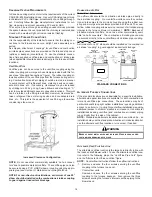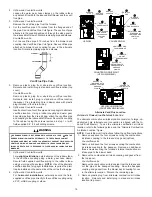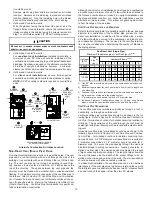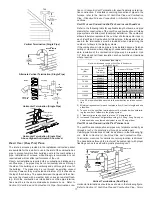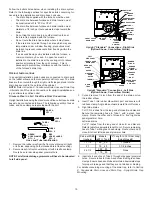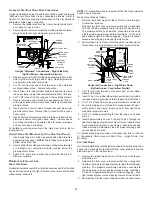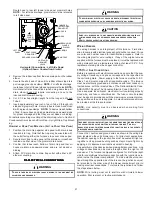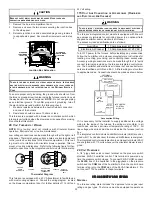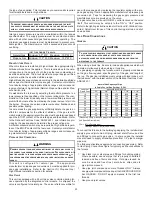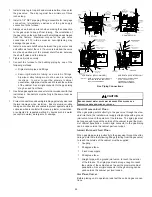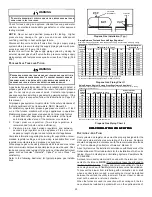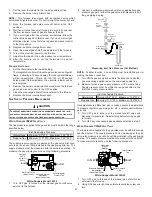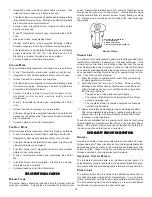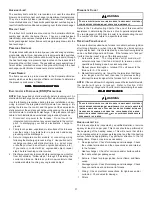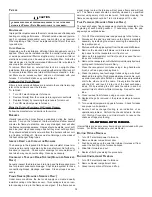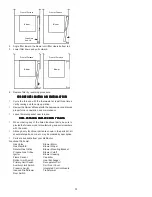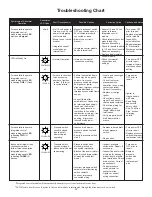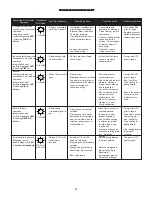
28
3.
Connect a 5/16 inch hose and calibrated water manometer
to the gas valve inlet pressure tap. The hose should overlap
the tap by 3/8 inch.
4.
Turn ON the gas supply and operate the furnace
5.
Leak test. Using a leak detection solution or non-chlorine
soap suds, check for leaks at hose connection. Bubbles
forming indicate a leak. SHUT OFF GAS AND FIX ALL
LEAKS IMMEDIATELY BEFORE PROCEEDING TO NEXT
STEP!
6.
Measure furnace gas supply pressure. Supply pressure must
be within the range specified in the
Inlet Gas Supply Pressure
table.
If supply pressure reading differs from the table, make
necessary adjustments to pressure regulator, gas piping size,
etc., and/or consult with local gas utility.
7.
Turn OFF gas to furnace at the manual shutoff valve and
disconnect manometer and hose. Reinstall plug before
turning on gas to furnace.
8.
Seal pressure port. Tighten inlet pressure tap screw
clockwise 7 in-lbs. minimum.
9.
Retest for leaks. If bubbles form, shut down gas and fix leaks
immediately.
10. Turn valve switch ON.
G
AS
M
ANIFOLD
P
RESSURE
M
EASUREMENT
AND
A
DJUSTMENT
CAUTION
T
O PREVENT UNRELIABLE OPERATION OR EQUIPMENT DAMAGE, THE GAS
MANIFOLD PRESSURE MUST BE AS SPECIFIED ON THE UNIT RATING PLATE.
O
NLY MINOR ADJUSTMENTS SHOULD BE MADE BY ADJUSTING THE GAS VALVE
PRESSURE REGULATOR.
W
HITE
-R
ODGERS
36F22 G
AS
V
ALVE
Only small variations in gas pressure should be made by adjusting
the gas valve pressure regulator. The manifold pressure must be
measured with the burners operating. To measure and adjust the
manifold pressure, use the following procedure.
1.
Turn OFF gas to furnace at the manual gas shutoff valve
external to the furnace.
2.
Connect a calibrated water manometer (or appropriate gas
pressure gauge) at the gas valve outlet pressure tap (refer
to gas valve figure in previous section).
3.
Turn ON the gas supply and operate the furnace.
4.
Measure gas manifold pressure with burners firing. Adjust
manifold pressure using the
Manifold Gas Pressure
table
shown.
Manifold Gas Pressure
Natural Gas
3.5" w.c.
Propane Gas
10.0" w.c.
The final manifold pressure must not vary more than ± 0.3 “ w.c.
from the above specified pressures. Any necessary major changes
in gas flow rate should be made by changing the size of the burner
orifice.
5.
To adjust the gas valve pressure regulator, remove the
regulator cap.
6.
Turn the adjustment screw clockwise to increase the pressure,
or counterclockwise to decrease the pressure.
7.
Securely replace the regulator cap.
8.
Turn OFF gas to furnace at the manual shutoff valve and
disconnect manometer.
9.
Reinstall gas valve outlet pressure tap plug before turning
on gas to furnace.
W
HITE
-R
ODGERS
36G22 G
AS
V
ALVE
This valve is shipped from the factory with the regulator preset (see
control label).
Consult the appliance rating plate to ensure burner manifold pres-
sure is as specified. If another outlet pressure is required, follow
these steps.
1.
Turn OFF all electrical power to the system.
2.
Using a 3/32 inch hex wrench, loosen outlet pressure tap
screw one turn. Do not remove screw.
3.
Connect a calibrated water manometer and 5/16 inch hose
to the gas valve outlet pressure tap. Hose should overlap
tap by 3/8 inch.
4.
Turn ON system power and set thermostat to a call for heat.
5.
Using a leak detection solution or non-chlorine soap suds,
check for leaks at hose connection. Bubbles forming indicate
a leak. SHUT OFF GAS AND FIX ALL LEAKS IMMEDIATELY!
6.
Remove regulator screw cover. Turn regulator screw either
clockwise to increase pressure or counterclockwise to
decrease. Always adjust regulator to provide the correct
pressure according to the original equipment manufacturer
specifications listed on the appliance rating plate.
7.
Replace regulator screw cover and finger-tighten securely.
8.
Turn OFF all electrical power to the system.
9.
Remove manometer and hose from outlet pressure tap.
10. Tighten outlet pressure tap clockwise 7 in-lbs minimum to
seal port.
11. Turn ON system power and set thermostat to call for heat.
12. Using a leak detection solution or non-chlorine soap suds,
check for leaks at hose connection. Bubbles forming indicate
a leak. SHUT OFF GAS AND FIX ALL LEAKS IMMEDIATELY!
Measure gas manifold pressure with burners firing. Adjust manifold
pressure per the
Manifold Gas Pressure
table.
Any necessary major changes in gas flow rate should be made by
changing the size of the burner orifice.
G
AS
I
NPUT
R
ATE
M
EASUREMENT
(N
ATURAL
G
AS
O
NLY
)
The gas input rate to the furnace must never be greater than that
specified on the unit rating plate. To measure natural gas input
using the gas meter, use the following procedure.
1.
Turn OFF the gas supply to all other gas-burning appliances
except the furnace.
2.
While the furnace is operating, time and record one complete
revolution of the smallest gas meter dial.
3.
Calculate the number of seconds per cubic foot (sec/ft
3
) of
gas being delivered to the furnace. If the dial is a one cubic
foot dial, divide the number of seconds recorded in step 2 by
one. If the dial is a two cubic foot dial, divide the number of
seconds recorded in step 2 by two.
4.
Calculate the furnace input in BTUs per hour (BTU/hr). Input
equals the sum of the installation’s gas heating value and a
conversion factor (hours to seconds) divided by the number
of seconds per cubic foot. The measured input must not be
greater than the input indicated on the unit rating plate.
EXAMPLE:
Installation’s gas heating (HTG) value: 1,000 BTU/ft
3
(Obtained from gas supplier)
Installation’s seconds per cubic foot: 34 sec/ ft
3

